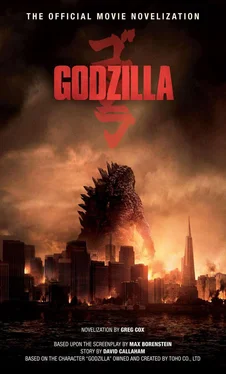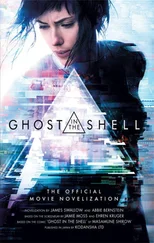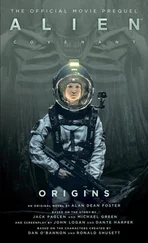I knew this was a bad idea , he thought.
Another helicopter buzzed by overhead, and the two men ducked beneath the tattered awning of a vacant sidewalk café to avoid being spotted. Ford tracked the chopper’s progress. It was flying northeast toward the horizon, where he now spotted what appeared to be a large metal structure in the distance. Glowing lights illuminated a towering assemblage of new scaffolding and facilities — right where the nuclear power plant used to be.
He looked to his father in confusion. “Are they rebuilding the plant?”
Joe stared at the distant complex intently, too transfixed by the sight to reply. You could practically see the gears turning behind his eyes as the former engineer tried to absorb this unexpected new development. And yet, Ford observed, his father didn’t appear to be too surprised to find something happening at the old site, just as he’d theorized earlier. For the first time in years, Ford actually felt like Joe Brody had a better grip on what was going than he did.
How weird was that?
He opened his mouth again, to ask his dad to explain, only to be interrupted by the unmistakable sound of an assault rifle being racked. Ford’s mouth went dry.
The men turned around to find a pair of uniformed Japanese soldiers standing behind them, their Howa assault rifles aimed at the trespassers. Neither soldier was wearing a radiation suit, just ordinary camo gear. They shouted at the Americans in a torrent of angry Japanese. Ford couldn’t make out what they were saying, but raised his hands in the air.
“What are they saying?” he whispered to Joe.
Belligerent expressions conveyed a lack of hospitality. More choppers thundered past overhead, heading for the mysterious new facility.
“We’re screwed,” Joe said.
The unmarked security van rumbled down an access road deep in the heart of the Q-Zone. It bounced as it crossed a wooden bridge. The bump jarred the bench beneath Ford, who grunted in response. Things were not going well.
He and Joe sat handcuffed to a steel rail in the back of the van, flanked by two unsmiling Japanese soldiers, who had so far ignored all of Ford’s urgent queries as to what was going to happen next. Ford didn’t know if the guards didn’t speak English and couldn’t understand his feeble attempts at Japanese, or if they were just under orders to not engage with the prisoners, but what they had here was a definite failure to communicate. Ford had even tried explaining that he was a U.S. Navy lieutenant, but to no avail. It was clear that this wasn’t going to get straightened out right away.
How on Earth was he going to explain this to his superiors? Or Elle?
Night had fallen, throwing the Q-Zone into darkness, but Ford watched through the rear window as the van drove past numerous military vehicles, heavy equipment, and construction cranes on their way to the massive facility they had spied earlier. The van pulled up to the gates, where a guard conferred with the driver in Japanese. He scoped out the prisoners before waving the van through. Ford guessed that they had arrived at their destination, whatever it was.
Some sort of top-secret base? On top of the old nuclear plant?
Their captors had strongly discouraged the prisoners from conversing with each other. Still, Ford shot a questioning look at Joe.
What the hell have you gotten us into?
* * *
A security van passed beneath the elevated steel gantry supporting Serizawa as he and Dr. Graham made their way toward an observation post above the pit. Both scientists wore protective radiation suits, having just toured the restricted level directly above the buried power plant.
“Fifteen years of silence,” Graham recounted, shaking her head. “Then two weeks ago, these pulses. As of yesterday, it’s up to one an hour and stronger every time. Whelan’s practically walking on air, calling it a living fuel cell. All this time absorbing radiation like a sponge… and suddenly it’s gone electric.”
Serizawa shared his colleague’s astonishment. These were truly stunning developments. He only wished he knew whether they boded ill or not. Unlike the esteemed Dr. Whelan, who was the chief scientist in charge of the operation, Serizawa was not entirely convinced that this was cause for celebration. Now in his fifties, he still remembered that devastated mine in the Philippines — and the many lives that had been lost there.
They stepped to a safety rail overlooking a gigantic sinkhole, even larger than the one they had encountered fifteen years ago. Graham signaled Serizawa that it was now safe to remove their safety masks. She gazed in awe at the sight below.
“Nature is spectacular,” she observed.
He shook his head. “Nature didn’t cause this. We did.”
Where the Janjira Nuclear Power Plant had once stood was an enormous pit, more than one hundred meters across. An elaborate multi-story edifice of steel scaffolding and catwalks lined the walls of the sinkhole, descending dozens of levels. Six towering construction cranes were in place around the rim of the pit, bracketing it. Spotlights illuminated the sinkhole. And this entire imposing superstructure, Serizawa knew, had been constructed to monitor a single biological specimen.
The cocoon rested on the floor of the pit, many meters below. Nearly as tall as the pit itself, it was a gnarled, rocky extrusion roughly the size of a fifteen-story building. A bioluminescent red glow came from deep within its thick translucent husk. It was many times larger and denser than the twin egg sacs they had discovered in the Philippines years ago. Its pointed tip curled down towards its base, so that it vaguely resembled a claw or pincer. Its roots were sunken deep into the mangled ruins of the collapsed nuclear power plant buried beneath it.
A complex array of monitoring equipment surrounded the base of the cocoon. Huge cameras, sensors, and scanners probed the cocoon across the entire range of the electromagnetic spectrum. The imposing apparatus, which were at least a story in height, rested upon a ring of grilled metal flooring surrounding the cocoon. Along with Graham, Serizawa watched from above as crews of workers, wearing hazmat suits, scurried about below, attending to the equipment. The flurry of new pulses had the entire base in an uproar, adding new urgency to its operations. Serizawa had gotten on a plane the minute he’d received word from Graham that the cocoon had become active and was manifesting new characteristics. She had just given him a firsthand look at the activities down on the floor of the pit.
“Get ready,” she told him. “Here it comes.”
All at once, the cocoon flashed brightly. A dazzling burst of light briefly turned night into day.
* * *
The van skidded to a stop, throwing Ford and his dad forward. Handcuffs tugged on Ford’s wrist, yanking him back; he would’ve preferred a seatbelt. Numerous voices and footsteps could be heard outside the van. Something’s up , he guessed. Now what?
Their guards whipped open the side door. Gruff words were exchanged in Japanese. Grabbing the prisoners’ duffel bag and gear, the soldiers scrambled out of the van and slammed the door shut behind them, leaving Ford and Joe alone in the back of the van. He figured now was their chance to finally talk to each other. Ford hoped to hell his dad knew what this about, because he was totally lost.
“Okay, okay,” he said, trying to get a handle on the situation. “So the good news is that we’re not going to fry from radiation poisoning.” He looked to his dad for confirmation, but Joe seemed lost in a world of his own, staring bleakly at the floor of the van. It dawned on Ford that his father had barely said a word, or even made eye contact with him, since the guards had taken them into custody. “Hey, Dad. You okay?”
Читать дальше












